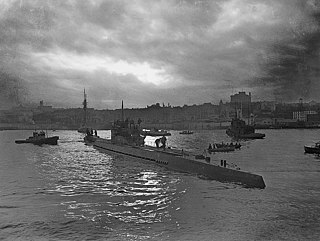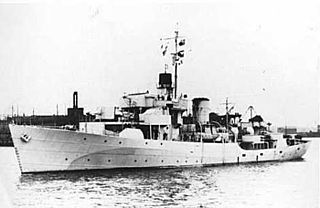Related Research Articles
Quebec is a French-speaking province in Eastern Canada.
Several Canadian naval units have been named HMCS Vancouver. One was named for the explorer George Vancouver, the others after the city of Vancouver.

HMCS Ville de Québec is a Halifax-class frigate that has served in the Canadian Forces and Royal Canadian Navy since 1993. Ville de Québec is the third vessel in her class which is the name for the Canadian Patrol Frigate Project. The frigate is the second Royal Canadian Navy ship to be named Ville de Québec and is Canada's only fully bilingual warship. She is assigned to Maritime Forces Atlantic (MARLANT) and is homeported at CFB Halifax. The vessel serves on MARLANT missions protecting Canada's sovereignty in the Atlantic Ocean and enforcing Canadian laws in its territorial sea and exclusive economic zone.
Four Canadian naval units have been named HMCS Ottawa.

HMCS Ontario can refer to several ships:

The Battle of the St. Lawrence involved marine and anti-submarine actions throughout the lower St. Lawrence River and the entire Gulf of Saint Lawrence, Strait of Belle Isle, Anticosti Island and Cabot Strait from May–October 1942, September 1943, and again in October–November 1944. During this time, German U-boats sank over 20 merchant ships and four Canadian warships. There were several near-shore actions involving the drop of German spies, or the attempted pickup of escaping prisoners of war. Despite the 23 ships lost, this battle marked a strategic victory for Canadian forces as ultimately they managed to disrupt U-boat activity, protect Canadian and Allied convoys, and intercept all attempted shore operations. This marked the first time that a foreign power had inflicted casualties in Canadian inland waters since the US incursions in the War of 1812.
Several Canadian naval units have been named HMCS Quebec.
Eight ships of the Royal Navy have borne the name HMS Bonaventure, and another was planned:

Vice Admiral Henry George DeWolf was a Canadian naval officer who was famous as the first commander of HMCS Haida during the Second World War.
Several Canadian naval units have been named HMCS Kootenay.
Two Canadian naval units have been named HMCS Assiniboine.
Several Canadian naval units have carried the name HMCS Champlain:

The River class was a class of fourteen destroyers of the Royal Canadian Navy (RCN) that served before and during the Second World War. They were named after Canadian rivers.
Three ships of the Royal Navy have borne the name HMS Crusader, after the participants in the Medieval Crusades:
Three ships and a shore establishment of the Royal Navy have borne the name HMS Quebec, after the city of Quebec in Canada:
At least three ships of the Royal Navy have been named HMS Candytuft :

HMCS Fennel was a Flower-class corvette that served primarily with the Royal Canadian Navy during the Second World War. Originally commissioned into the Royal Navy, she served as an ocean escort in the Battle of the Atlantic.

HMCS Ville de Québec was a Royal Canadian Navy revised Flower-class corvette which took part in convoy escort duties during the Second World War. She fought primarily in the Battle of the Atlantic. She was named for Quebec City, Quebec. Following the war, the ship was sold to commercial interests, in service until 1952.

HMCS Giffard was a modified Flower-class corvette that served with the Royal Canadian Navy during the Second World War. She served primarily as a convoy escort in the Battle of the Atlantic. She was originally laid down by the British Royal Navy as HMS Buddleia but was never commissioned into the former, being transferred to the Royal Canadian Navy before completion. She is named for Giffard, Quebec, which at the time was a small village, but was eventually amalgamated into first, Beauport Quebec and then finally, Quebec City.

HMCS Mimico was a modified Flower-class corvette that served with the Royal Canadian Navy during the Second World War. She served primarily as a convoy escort in the Battle of the Atlantic. She was originally laid down by the Royal Navy as HMS Bullrush but was never commissioned into the RN, being transferred to the RCN before completion. She is named for Mimico, Ontario, a town that was eventually amalgamated into the larger city Toronto, Ontario.
References
- Directory of History and Heritage – HMCS Ville de Québec Archived 2014-10-06 at the Wayback Machine